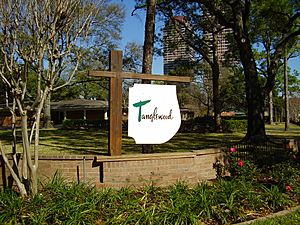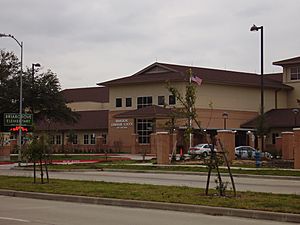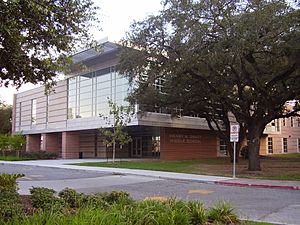Tanglewood, Houston facts for kids
Tanglewood is a fancy neighborhood in western Houston, Texas. It's located near San Felipe Road, just outside the 610 Loop and inside Beltway 8, in the Uptown Houston area. The Tanglewood Corporation first built this neighborhood. Today, the Tanglewood Homes Association helps manage it. In 1997, a reporter from the Houston Chronicle called Tanglewood "a leafy, upscale subdivision," meaning it has lots of trees and nice homes. Barbara and George H. W. Bush, who were important figures in American politics, lived in Tanglewood for many years.
Contents
History of Tanglewood
William Giddings Farrington started developing Tanglewood in the 1930s. The neighborhood officially opened in 1949. The Farrington family chose the name "Tanglewood" from a book called "Tanglewood Tales" by Nathaniel Hawthorne. This book was a favorite of Farrington's daughter, Mary Catherine Farrington.
When Tanglewood first opened, no houses were sold for the first six months. Mary Catherine, whose married name was Miller, said this made her family very worried. However, after several big rainstorms caused floods in other parts of Harris County, people started asking about houses in Tanglewood. They had heard that the neighborhood was built to handle water well and didn't flood easily. This good drainage helped Tanglewood become popular.
Geography and Nature
Tanglewood is only a short drive from Downtown Houston. The area is known for its many trees, with about 5,000 trees in total. Before Tanglewood was built, this land was mostly grassy plains. Wildfires used to happen often, which stopped trees from growing. But after Tanglewood was developed, these fires were controlled, allowing trees to flourish. By 1997, builders in the area worked with groups that wanted to protect trees, trying to save as many as possible in new projects.
Tanglewood Boulevard is a beautiful street lined with live oak trees. These trees were planted by the Tanglewood Garden Club. The boulevard also has benches where people can relax, and it's a popular spot for residents to gather. There's also a bike path and walking trails, making it a great place for outdoor activities. The Houston Business Journal mentioned that these nice features were made possible by the Tanglewood Foundation and generous residents.
Neighborhood Look
In 1992, a real estate agent named John Daugherty described Tanglewood as a "very low-key, unassuming neighborhood." He noted that many important business leaders and top managers chose to live there.
Tanglewood is known for its large lots and many oak trees. In 2003, the bigger lots were about .5 acres (0.20 ha) in size, while smaller ones were around 100 feet (30 m) by 150 feet (46 m). At that time, land in Tanglewood cost about $34 to $35 per square foot. This was less expensive than land in other fancy Houston neighborhoods like River Oaks (which cost $65–$70 per square foot) or West University Place (around $50 per square foot). Donna Ellis, a real estate expert, explained that Tanglewood offered "so much more for your money" because the lots were much larger than in those other areas.
Houses in Tanglewood
As of 2003, Tanglewood had 1,144 houses. The average house value was about $632,750. Houses typically had four bedrooms and 4.2 bathrooms. The average lot size was 16,390 square feet (1,523 m2), and the average house size was 3,882 square feet (360.6 m2). Donna Ellis said that house prices in Tanglewood could range from $300,000 to $3 million. Most of the houses in Tanglewood by 2003 were newer homes built starting in the 1980s.
In 1992, Tanglewood had around 1,800 houses, including many "Rambling Ranches" and some Tudor-style homes. By November 1992, prices for homes in Tanglewood had "zoomed heavenward," meaning they had increased a lot. Many people were buying older houses just to tear them down and build new, larger ones. Some of these new multi-story homes seemed to take up almost all of the large lots. An older house meant for demolition could cost around $350,000 in 1992.
By 1994, most Tanglewood houses were still the older "rambling Ranch" style, but more new houses were being built. In that year, there were 1,157 houses. The average house value was $403,200.
Housing Styles
The first homes built in Tanglewood were "rambling Ranch" houses. These were spread-out, one-story homes on big lots, and they came with central air conditioning. The very first houses in Tanglewood cost around $25,000. By 2003, any original houses that were still standing had been updated with expensive features. An older house without any improvements could cost about $350,000 in 1994.
Newer houses started replacing the older ones in the 1980s. By 2003, these newer homes made up most of the houses in the neighborhood. These new styles included two-story English-style homes made of brick and stone, and Mediterranean-style stucco houses with clay roofs. Many of these newer homes feature high ceilings (about 11-foot (340 cm)), three-car garages, and even wine cellars. Katherine Feser of the Houston Chronicle noted that Tanglewood's large lots were "well-suited" for these bigger, newer homes. In 1994, a popular new style was influenced by the Italian designer Andrea Palladio, featuring stucco, balanced designs, tile roofs, and arched windows. Most new houses in 1994 started at $800,000. Mary Catherine Miller, the daughter of the founder, said that Tanglewood "offers all of the amenities of a well-planned community and it has really stood the test of time."
Community Life
In the 1960s, a reporter from the Houston Chronicle described Tanglewood as a very traditional community. She said that people in Tanglewood often went to the same grocery store, pharmacy, hardware store, and dry cleaners. They often belonged to the Houston Country Club, supported similar politicians, and attended a few main churches. This created a very close-knit and predictable community feeling.
Education for Tanglewood Kids
Public Schools
The Houston Independent School District runs the public schools for Tanglewood.
Children in Tanglewood usually go to Briargrove Elementary School (located in Briargrove) and Tanglewood Middle School. Tanglewood Middle School used to be called Grady Middle School, and the land it sits on was actually given by a Tanglewood developer. For high school, students are zoned to Margaret Long Wisdom High School (which was formerly Robert E. Lee High School). They also have the option to attend Lamar High School or Westside High School. Even though Wisdom High School is the main school for Tanglewood, many parents in this area choose to send their children to Lamar, Westside, or private schools.
Students who live in the Briargrove Elementary School area can also apply to the Briarmeadow Charter School.
The school board voted to change Grady Middle School's name to Tanglewood Middle School in 2016.
Mark White Elementary School was planned to open in August 2016. Students from the Briargrove Elementary zone, along with other nearby zones, can apply to this new school.
The T.H. Rogers School, which is a special K-8 school for gifted and talented students, deaf students, and students with multiple disabilities, is also close to Tanglewood.
Private Schools
There are several private schools in the area. St. Michael School is a Roman Catholic school for grades K-8. The Al-Hadi School of Accelerative Learning is a private K-12 Islamic school nearby.
Other private schools in the wider Houston area include Strake Jesuit College Preparatory and Saint Agnes Academy (both in Sharpstown), and Saint Thomas High School. Also, St. John's School and The Kinkaid School are not far away.
Public Libraries
The closest public library branch for Tanglewood residents is the Jungman Library, part of the Houston Public Library.
Local News and Media
The Houston Chronicle is the main newspaper for the Houston area.
The Memorial Examiner is a local newspaper that is given out in the Tanglewood community.
The Tanglewood and River Oaks Buzz is a monthly magazine that focuses on people, businesses, and services in the community. It is mailed for free to all residents each month.
Parks and Recreation
The city of Houston manages Tanglewood Park, located at 5801 Woodway.
Around 2003, some city-funded improvements were being made to Tanglewood Park. At that time, children from Tanglewood even helped by collecting coins to raise money for a new playground!
The closest YMCA (Young Men's Christian Association) is the Post Oak YMCA.
Famous People from Tanglewood
- George H. W. Bush and Barbara Bush
- Billy Gibbons (from the band ZZ Top)
- Joel Osteen (a well-known pastor)
- Matt Schaub (a former professional football player)
- James Harden (a professional basketball player)
George H. W. Bush's Life in Tanglewood
Former U.S. president George H. W. Bush and First Lady Barbara Bush lived in the Tanglewood area for a long time. All three houses they owned in Houston were in Tanglewood, and Mr. Bush even started his political career while living there. A reporter from the Houston Chronicle said the Bush family had "deep roots" in Tanglewood.
The Bushes moved into a house on Indian Trail in the 1960s. While living in Tanglewood, they sent their children to The Kinkaid School. The family often shopped at local stores like Rice Food Market (now Rice Epicurean Market), Patterson Hardware & Garden Supply, and Miller's Laundry & Cleaners. George H. W. Bush enjoyed playing golf and tennis at the nearby Houston Country Club. He represented the Tanglewood community as a U.S. Congressman. He also liked to eat at local restaurants like Molina's, Otto's Barbecue, Hunan, and Ninfa's on Navigation.
Later, Mr. Bush moved out of Houston as his political career grew, and he sold his Indian Trail house. He continued to own another house in Tanglewood, which had five bedrooms.
In 1981, when Mr. Bush became Vice President of the United States, he sold his Tanglewood house. This led to a discussion with the Internal Revenue Service about taxes. While away from Houston, the Bushes considered The Houstonian Hotel, which is in the Tanglewood area, as their official home. To settle the tax discussion, in 1985, Mr. Bush agreed to build his retirement home on a lot in West Oaks. This area was just outside the main Tanglewood neighborhood but still considered part of the larger Tanglewood area.
After leaving Washington, DC, the Bushes temporarily rented a house from a family friend. In December 1992, they announced they were building their new house on the West Oaks lot. By 1994, the Bushes were living in this West Oaks house. Even in 1992, Mr. Bush still attended church at St. Martin's Episcopal Church, which is also in the Tanglewood area.
|




